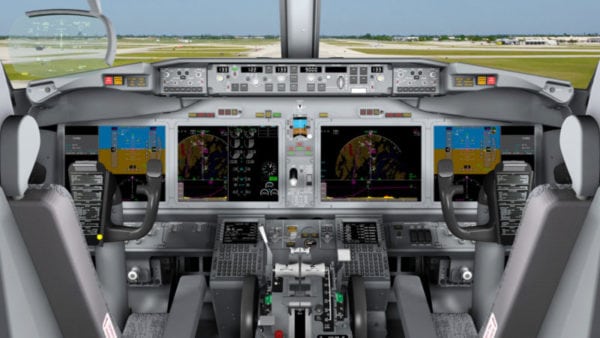
737 MAX Flight Deck. Photo courtesy of Boeing
The FAA has issued a new airworthiness directive (AD) on the Boeing 737 MAX after Lion Air flight JT610 crash investigators found the aircraft’s angle of attack (AOA) sensors are capable of generating erroneous inputs, potentially making the aircraft difficult for pilots to control.
A statement and copy of the new directive obtained by Avionics International notes that the agency is issuing an emergency AD requiring a Boeing 737 MAX flight operations manual update. The directive comes a little more than a week after Lion Air pilots operating a 737 MAX 8 lost contact with Soekarno-Hatta’s air traffic control (ATC) and crashed into the Java Sea, north of Indonesia’s Java Island.
After safety officials from Basarnas, Indonesia’s national search and rescue agency, retrieved the aircraft’s flight data recorder (FDR), a review of the data by Boeing and Indonesian safety investigators pointed to the plausible cause of the crash. FDR data resulted in investigators determining that if an erroneously high single AOA sensor input is received from the aircraft’s flight control system, there is a potential for the 737 to repeatedly perform nose-down trim commands of its horizontal stabilizer.
Representatives for the FAA’s aircraft certification service confirmed that airlines will have three days after receiving the AD to revise the certificate limitations chapter of their 737 MAX aircraft flight manuals. The AD currently affects 246 total Boeing 737 MAX aircraft in service globally.
On Nov. 5, CNN published an update on the crash investigation from Capt. Nurcahyo Utomo of Indonesia’s National Transportation Safety Committee (KNKT) noting that the FDR review also concluded that the aircraft’s airspeed indicator had been malfunctioning on four consecutive flights prior to the crash. Utomo also indicated the pilots should have recognized the malfunction when it occurred on flight JT610.
A description of the unsafe condition that results from erroneously high single AOA notes that when repeated nose-down trim commands of the horizontal stabilizer occur, it can result in nose-down trim. Resulting effects include excessive nose-down attitude of the aircraft and significant altitude loss as well as possible impact with terrain.
While the ultimate cause of the crash is still under investigation, Boeing has previously provided guidance on how pilots should deal with extreme nose down incidents. The image below was retrieved from an article on the 737 MAX published in a magazine internally distributed to Boeing employees:

The directive notes that the 737 MAX uses a flight control computer to command the aircraft’s pitch trim system. When the AOA sensor input to the computer is erroneous, it can result in a trim of the stabilizer to a nose down position in increments lasting up to 10 seconds. Pilots flying with an AOA sensor generating erroneous inputs to the system can experience the inability to engage the aircraft’s autopilot system, among other problems.
“The AD orders operators to revise the airplane flight manual (AFM) to give the flight crew horizontal stabilizer trim procedures to follow under certain conditions,” the FAA said in an emailed statement.

An overview of the 737 MAX flight manual revision being issued by the FAA.
Boeing issued a statement on an update to the 737 MAX flight manual Nov. 6, a day after investigators discovered JT610’s faulty airspeed indicator.
“The investigation into Lion Air flight 610 is ongoing and Boeing continues to cooperate fully and provide technical assistance at the request and under the direction of government authorities investigating the accident,” it said.